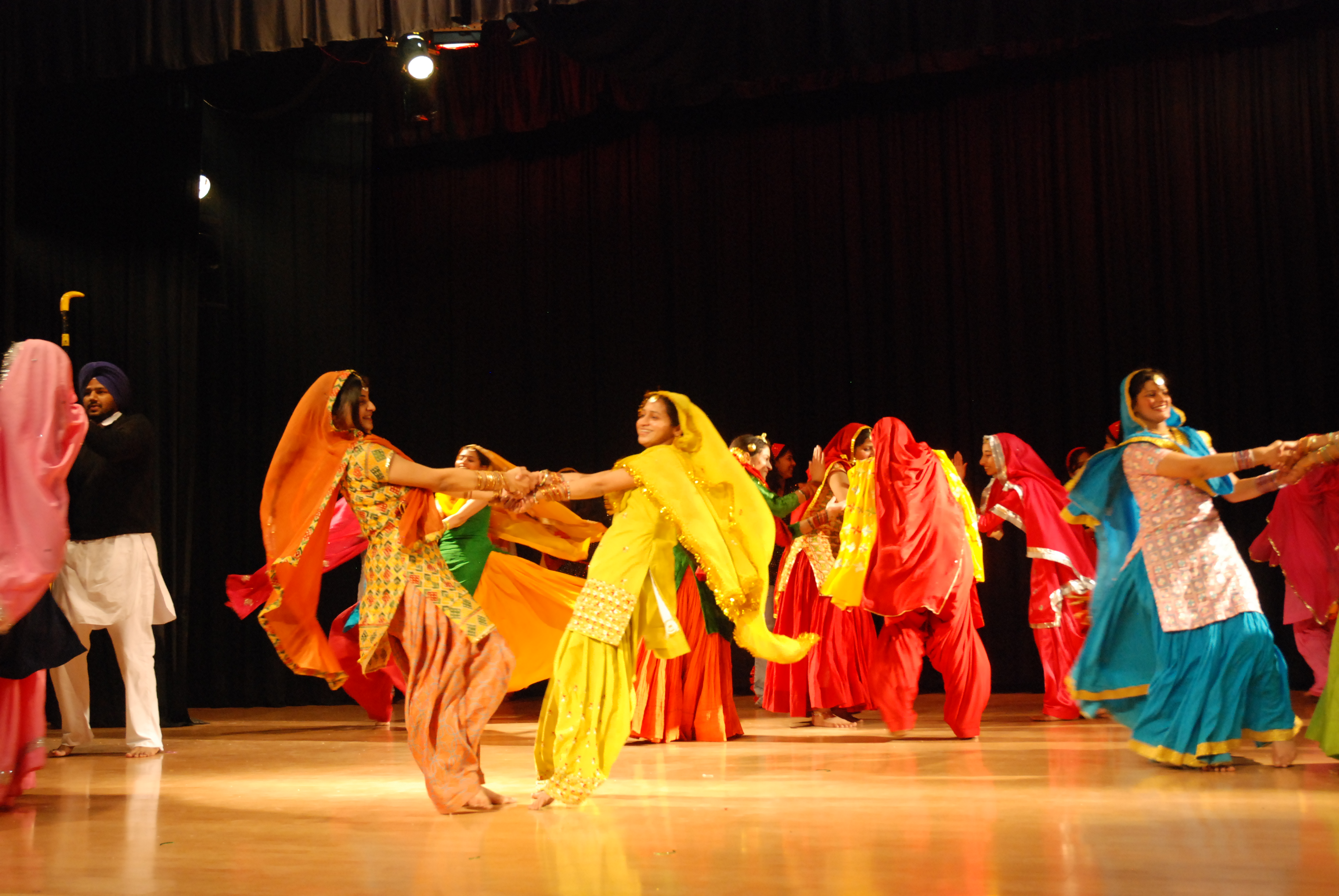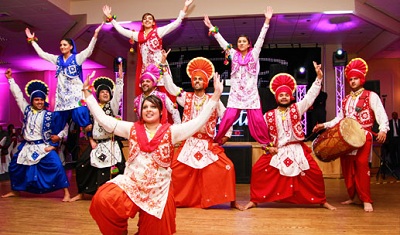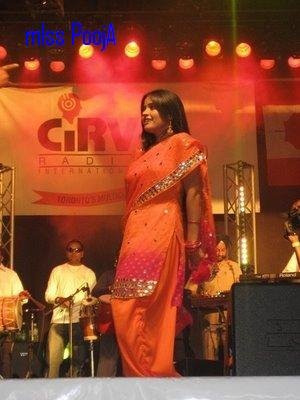|
Bhangra (dance)
Bhangra ( Punjabi: ਭੰਗੜਾ) is a type of traditional folk dance of Punjab area of the Indian subcontinent. According to Manuel (2001), bhangra is especially associated with the vernal Vaisakhi festival, performed during harvest season between April and the first quarter of May. In a typical performance, several dancers execute vigorous kicks, leaps, and bends of the body—often with upraised, thrusting arm or shoulder movements—to the accompaniment of short songs called '' boliyan'' and, most significantly, to the beat of a '' dhol'' (double-headed drum). Struck with a heavy beater on one end and with a lighter stick on the other, the ''dhol'' imbues the music with a syncopated (accents on the weak beats), swinging rhythmic character that has generally remained the hallmark of bhangra music. An energetic Punjabi dance, bhangra originated with Punjabi farmers as a cultural and communal celebration; its modern-day evolution has allowed bhangra to retain its traditional P ... [...More Info...] [...Related Items...] OR: [Wikipedia] [Google] [Baidu] |
Punjabi Language
Punjabi, sometimes spelled Panjabi, is an Indo-Aryan languages, Indo-Aryan language native to the Punjab region of Pakistan and India. It is one of the most widely spoken native languages in the world, with approximately 150 million native speakers. Punjabi is the most widely-spoken first language in Pakistan, with 88.9 million native speakers according to the 2023 Pakistani census, and the 11th most widely-spoken in India, with 31.1 million native speakers, according to the 2011 Census of India, 2011 census. It is spoken among a Punjabi diaspora, significant overseas diaspora, particularly in Canada, the United Kingdom, the United States, Australia, and the Arab states of the Persian Gulf, Gulf states. In Pakistan, Punjabi is written using the Shahmukhi alphabet, based on the Persian alphabet, Perso-Arabic script; in India, it is written using the Gurmukhi, Gurmukhi alphabet, based on the Brahmic scripts, Indic scripts. Punjabi is unusual among the Indo-Aryan languages and t ... [...More Info...] [...Related Items...] OR: [Wikipedia] [Google] [Baidu] |
Patiala
Patiala () is a city in southeastern Punjab, India, Punjab, northwestern India. It is the fourth largest city in the state and is the administrative capital of Patiala district. Patiala is located around the ''Qila Mubarak, Patiala, Qila Mubarak'' (the 'Blessed Castle') constructed by a chieftain Ala Singh, who founded the royal dynasty of Patiala State in 1763, and after whom the city is named. In popular culture, the city remains famous for its traditional ''Patiala Shahi Pagg, Patiala shahi'' turban (a type of headgear), ''Punjabi Paranda, paranda'' (a tasselled tag for braiding hair), ''Patiala salwar'' (a type of female trousers), ''jutti'' (a type of footwear) and Patiala peg (a measure of liquor). Patiala is also known as the Royal City and the Beautiful City. Etymology The name ''Patiala'' may mean either "great land" or "land of Ala Singh", the city's founder. History Patiala city was established in 1763 by Ala Singh, a Jat Sikh chieftain, who laid the foundation ... [...More Info...] [...Related Items...] OR: [Wikipedia] [Google] [Baidu] |
Punjabi Culture
Punjabi culture grew out of the settlements along the five rivers (the name ''Punjab'', is derived from two Persian words, ''Panj'' meaning "Five" and ''Âb'' meaning "Water") which served as an important route to the Near East as early as the ancient Indus Valley civilization, dating back to 3000 BCE. Agriculture has been the major economic feature of the Punjab and has therefore formed the foundation of Punjabi culture, with one's social status being determined by landownership. The Punjab emerged as an important agricultural region, especially following the Green Revolution during the mid-1960's to the mid-1970's, has been described as the "breadbasket of both India and Pakistan". Besides being known for agriculture and trade, the Punjab is also a region that over the centuries has experienced many foreign invasions and consequently has a long-standing history of warfare, as the Punjab is situated on the principal route of invasions through the northwestern frontier of the Ind ... [...More Info...] [...Related Items...] OR: [Wikipedia] [Google] [Baidu] |
Music Of Punjab
The music of Punjab reflects the traditions of the Punjab, Punjab region associated with Punjabi language. Punjab is currently divided into two parts: Punjab, India, East Punjab, in India, and Punjab, Pakistan, West Punjab, the most populous province of Pakistan. The Punjab has diverse styles of music, ranging from Folk music of Punjab, folk and Sufi music, Sufi to Indian classical music, classical, notably the Patiala gharana. Contemporary Punjabi music has tended to include more modern Hip hop music, hip-hop and Rhythm and blues, R&B sounds. While this style of music is obviously most popular in Punjab, it has seen popularity across the subcontinent and areas with large Punjabi diaspora populations, such as Canada, the United Kingdom, and the United States. Classical music *Patiala Gharana *Sham Chaurasia gharana *Punjab Gharana Instruments During the past century, Punjabi folk musicians used 87 instruments, 55 of which are still used today. It is notable that the instrument ... [...More Info...] [...Related Items...] OR: [Wikipedia] [Google] [Baidu] |
Folk Dances Of Punjab
Punjabi dances are an array of folk and religious dances of the Punjabi people indigenous to the Punjab region, straddling the border of India and Pakistan. The style of Punjabi dances ranges from very high energy to slow and reserved, and there are specific styles for men and women. Types Bhangra Bhangra is the most popular folk dance from Punjab, originating in the Sialkot area of Punjab, Pakistan.Dhillon, Iqbal S. (1998). ''Folk Dances of Punjab''. Delhi: National Book Shop. It is especially associated with the vernal Vaisakhi festival. Bhangra was mainly done by Punjabi farmers during the harvesting season. It was mainly performed while farmers did agricultural chores. As they did each farming activity they would perform bhangra moves on the spot. This allowed them to finish their job in a pleasurable way. After harvesting their wheat crops during the Vaisakhi season, people used to attend cultural festivals while dancing bhangra. For many years, farmers performed bhan ... [...More Info...] [...Related Items...] OR: [Wikipedia] [Google] [Baidu] |
Dhol
Dhol () can refer to any one of a number of similar types of double-headed drum widely used, with regional variations, throughout the Indian subcontinent. Its range of distribution in Indian subcontinent primarily includes northern areas such as the Jammu division, Jammu, Himachal Pradesh, Himachal, Punjab region, Punjab, Haryana, Delhi, Kashmir, Sindh, Assam Valley, Uttarakhand, West Bengal, Odisha, Gujarat, Maharashtra, Konkan, Goa, Karnataka, Rajasthan, Bihar, Jharkhand and Uttar Pradesh. A related instrument is the dholak or dholki. ''Dhols'' are amongst other events used in Indian wedding ceremony processions such as Baraat or ''Varyatra''. Someone who plays the dhol is known as ''dholi''. Etymology The word Dhol is derived from Sanskrit word ''ḍhola,'' a term for drum in Sanskrit language. Construction The dhol is a double-sided barrel drum played mostly as an accompanying instrument in regional music forms. In Qawwali music, the term ''dhol'' is used to describe ... [...More Info...] [...Related Items...] OR: [Wikipedia] [Google] [Baidu] |
Bhangra Empire
Established in 2006, Bhangra Empire is a San Francisco Bay Area dance team in California. The team is composed of undergraduates, graduate students, and recent graduates pursuing a variety of career paths while taking time to pursue Bhangra (dance), Bhangra and Punjabi people, Punjabi culture. The team has won 16 awards in four years. Popular culture President Obama's first State Dinner On November 24, 2009, Bhangra Empire performed at the first State Dinner hosted by President Barack Obama and the First Lady, Michelle Obama. The event honored its chief guest Prime Minister of India, Manmohan Singh and was held on the South Lawn of the White House in Washington, D.C. Along with Bhangra Empire, the entertainment lineup included the National Symphony Orchestra, A.R. Rahman, Kurt Elling, and Jennifer Hudson. The guest list included a mix of prominent figures in United States and Indian politics, business, and entertainment, including the President and First Lady, Secretary of ... [...More Info...] [...Related Items...] OR: [Wikipedia] [Google] [Baidu] |
Sammi (dance)
Sammi (Shahmukhi: سمّی) is a traditional dance form originating from the tribal communities of Punjab. The dance originates from Sandal bar but is also popular in other Bars and Pothohar region of Pakistani Punjab. History The dance is named after a young heroine of a legend, Sammi, who was madly in love and used to sing and dance as best as she could for the sake of her love. Costume The dancers are dressed in bright colored kurtas and full flowing skirts called Ghagra or Lehenga The ''lehenga'', ''lehanga'' ''or लेहंगा'' (also known as a ghagra, chaniyo, Paro, ''paavada'', or ''lacha'') is a form of ankle-length skirt from the Indian subcontinent. Different patterns and styles of traditional embroidery are .... A peculiar silver hair ornament is associated with this dance. Performance Like Giddha it is danced in a circle. The dancers stand in a ring and swing their hands bringing them up from the sides, right in front. The refrain of the most popu ... [...More Info...] [...Related Items...] OR: [Wikipedia] [Google] [Baidu] |
Bhangra Music
Bhangra () is a type of non-traditional music of Punjab originating from the Punjab region. Over the years, bhangra has evolved and gained popularity not only in South Asia but also around the world. It has become a significant part of the cultural identity of the Punjabi diaspora in countries like Australia, the United Kingdom, Canada, and the United States. Prior to this musical fusion, bhangra existed only as a dance form in the native Punjab. This Punjabi music was unique in that it was not traditional nor did it seek any authenticity. While the traditional folk music of Punjab has a set of melodies that are used by various singers, bhangra was a form of strict "band culture" in that new melodies were composed for each song. Therefore, the musicians were as important as the singers. Origins The roots of modern bhangra music date back to the Sikh Punjabi community in Punjab during the 1960s. An early pop music and modern recording group of this type of music in the Unite ... [...More Info...] [...Related Items...] OR: [Wikipedia] [Google] [Baidu] |
Punjabis
The Punjabis (Punjabi language, Punjabi: ; ਪੰਜਾਬੀ ; romanised as Pañjābī) are an Indo-Aryan peoples, Indo-Aryan ethnolinguistic group associated with the Punjab region, comprising areas of northwestern India and eastern Pakistan. They generally speak Majhi dialect, Standard Punjabi or various Punjabi dialects on both sides. Majority of the overall Punjabi population adheres to Islam with significant minorities practicing Sikhism and Hinduism and smaller minorities practicing Christianity. However, the religious demographics significantly vary when viewed from Pakistani and Indian sides, respectively, with over 95 percent of the Punjabi population from Pakistan being Punjabi Muslims, Muslim, with a small minority of Punjabi Christians, Christians and Punjabi Hindus, Hindus and an even smaller minority of Punjabi Sikhs, Sikhs. Over 57 percent of the population of the Indian state of Punjab is Sikh and over 38 percent Hindu with a small minority of Muslims and C ... [...More Info...] [...Related Items...] OR: [Wikipedia] [Google] [Baidu] |
Masculinity
Masculinity (also called manhood or manliness) is a set of attributes, behaviors, and roles generally associated with men and boys. Masculinity can be theoretically understood as Social construction of gender, socially constructed, and there is also evidence that some behaviors considered masculine are influenced by both cultural factors and biological factors. To what extent masculinity is biologically or socially influenced is subject to debate. It is Sex and gender distinction, distinct from the definition of the Male, biological male sex, as anyone can exhibit masculine traits. Standards of masculinity vary across different cultures and historical periods. In Western cultures, its meaning is traditionally drawn from being contrasted with femininity. Overview Standards of manliness or masculinity vary across different cultures, subcultures, ethnic groups and historical periods. Traits traditionally viewed as masculine in Western world, Western society include physical stren ... [...More Info...] [...Related Items...] OR: [Wikipedia] [Google] [Baidu] |
Teeyan
Teeyan (), also known as Teeyan Da Teohar (trans: the festival of women) or Teej, is a festival celebrated throughout Punjab which is dedicated to the onset of the monsoon and focuses on daughters sisters, and mothers. Celebration The festival is celebrated during the monsoon season from the third day of the lunar month of Sawan on the bright half, up to the full moon of Sawan (about 13 days), by women. Married women go to their maternal house to participate in the festivities.Alop Ho Raha Punjabi Virsa: Harkesh Singh KehalUnistar Books PVT Ltd In the past, it was traditional for women to spend the whole month of Sawan with their parents. Gifts Whether or not a married woman goes to her parents, brothers take a gift set to their sisters called a 'sandhara'. A sandhara includes a Punjabi Suit/sari, laddoo, bangles, mehndi (henna) and a swing. File:Boondi laddoo.JPG, Boondi laddoo File:"Bangles..jpg, Bangles File:Mehandi.jpg, Mehandi File:Shalwar kameez Colours.jpg, Punjab ... [...More Info...] [...Related Items...] OR: [Wikipedia] [Google] [Baidu] |








